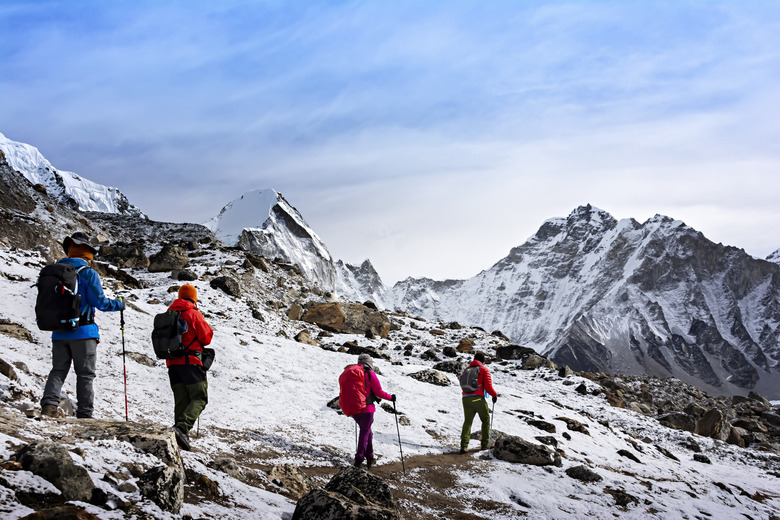Why This Year's Mount Everest Death Toll Is So High
It's climbing season on Mount Everest, and this year, it's almost as deadly as it's ever been.
Deadly seasons on the world's highest mountain usually happen thanks to factors beyond human control, such as blizzards or avalanches. In recent years, though, more and more adventurers and climbers – some far too inexperienced to withstand the harsh conditions and physical toll of climbing Everest – are being lured to the incredible peak.
It's tough for Nepal to turn away those adventure-seekers. Tourism brings in more than $2 billion per year to the country and supports nearly half a million jobs, largely thanks to crowds that want to experience Everest in some way. It's not a cheap endeavor to make it all the way to the top – it can run anywhere from $35,000 to $100,000, depending on the gear, permits and guides you need.
But it's those crowds that are contributing to this year's Everest death toll. Recent photos from the summit have shown a traffic jam at the top, with a long, tight line of climbers waiting for their selfie atop the mountain. Climbers who made it out alive called the peak a "zoo," with people jostling for photos and even having to climb over a dead body to make it all the way up.
Those long waits to the summit aren't just annoying. They're deadly. Oxygen is dangerously thin that high in the air, so climbers must carry oxygen masks and canisters with them in order to survive. For the last part of the climb, they leave behind the majority of their gear and simply climb with the outerwear and oxygen they need for what should be a few hours of ascent and descent. But this year, climbers and sherpas reported that some didn't anticipate the long wait time at the top, and didn't bring enough oxygen to cover them in those hours of delay.
Other preventable deaths and injuries have happened to inexperienced climbers, both this year and in recent years. There are smaller mountains around the world that can be climbed by relatively inexperienced adventure-seekers, but Everest is not one of them. Climbers with improper gear, a lack of understanding of how to help those around them in times of emergency or no experience dealing with oxygen fatigue can endanger both themselves and their fellow climbers.
Deadly for the Mountain, Too
Deadly for the Mountain, Too
It's impossible to ignore the environmental impact that so many climbers, especially inexperienced ones, are having on one of the world's most majestic sites. More climbers means more garbage, plain and simple. Sometimes referred to as "The World's Highest Rubbish Dump," devastating images have shown the beautiful peak littered with discarded climbing gear, oxygen canisters and empty food containers. One climber said you don't need a map to get to Everest base camp, you just need to follow the trash.
More climbers also means more poop. One environmental group recently trekked 28,000 pounds of human waste down from the mountain, hoping to clean up the land, stop it from contaminating nearby water supplies and dispose of it in an environmentally friendly way.
Climate change isn't helping. As the mountain warms, ice is melting, meaning that some of the trash, poop and body parts that have been buried for decades are now being unearthed.
Is Anything Going to Change?
Is Anything Going to Change?
Hopefully! When the news of Nepal's deadly season started to break, Nepal first said they would still continue to issue high numbers of permits to people wishing to climb the mountain. This year, 381 people were granted permits to scale the mountain, which many believe is the highest number of permits ever granted. But as the story spread, some Nepalese politicians have spoken out in the hopes of creating some criteria to make sure that every Everest climber knows what they are doing.
Environmental groups are also trying to do what they can to help climbers lower their carbon footprint on Everest and keep the mountain pristine. They are encouraging tour operators to climb with more eco-friendly gear and take everything (poop included!) with them when they descend. Cleanup groups have taken thousands of pounds of trash down to dispose of it properly.
Unfortunately, lives have been lost and much damage has already been done to the mountain. Keep that in mind if you've ever had grand dreams of a selfie atop Everest. The picture might last forever, but so can your carbon footprint. If you're heading out into one of our world's natural wonders, do your homework beforehand, and learn how you can experience it all while also leaving nothing harmful behind.
Cite This Article
MLA
Dragani, Rachelle. "Why This Year's Mount Everest Death Toll Is So High" sciencing.com, https://www.sciencing.com/whats-up-with-all-these-people-dying-on-everest-13719336/. 4 June 2019.
APA
Dragani, Rachelle. (2019, June 4). Why This Year's Mount Everest Death Toll Is So High. sciencing.com. Retrieved from https://www.sciencing.com/whats-up-with-all-these-people-dying-on-everest-13719336/
Chicago
Dragani, Rachelle. Why This Year's Mount Everest Death Toll Is So High last modified March 24, 2022. https://www.sciencing.com/whats-up-with-all-these-people-dying-on-everest-13719336/
